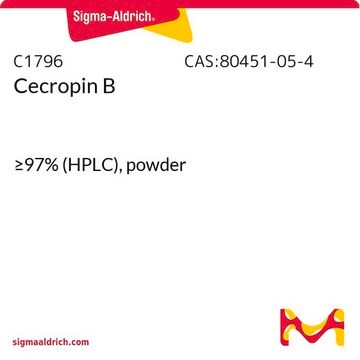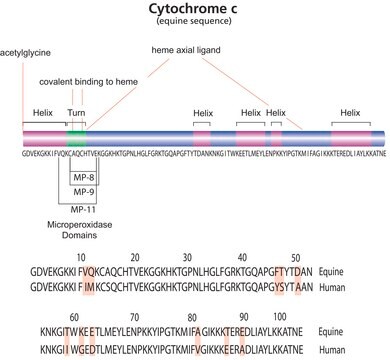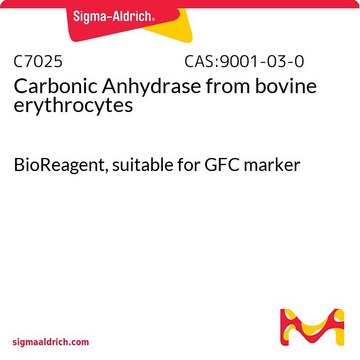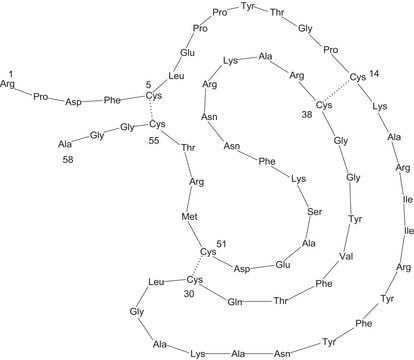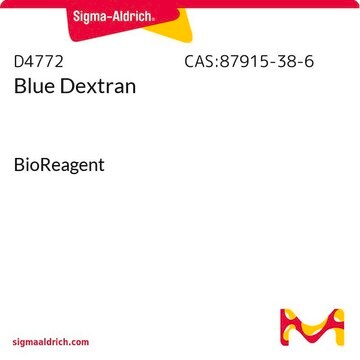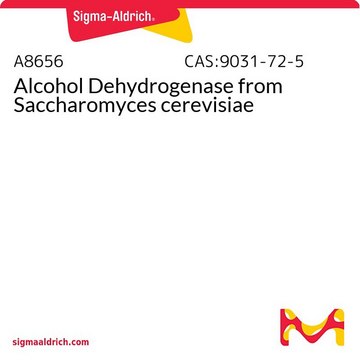C7150
Cytochrome c from equine heart
suitable for GFC marker, BioReagent
Synonim(y):
Cytochrome c from horse heart
Zaloguj sięWyświetlanie cen organizacyjnych i kontraktowych
About This Item
Polecane produkty
linia produktu
BioReagent
Poziom jakości
Formularz
powder
masa cząsteczkowa
~12,400
opakowanie
vial of ≥10 mg
przydatność
suitable for GFC marker
temp. przechowywania
−20°C
Szukasz podobnych produktów? Odwiedź Przewodnik dotyczący porównywania produktów
Zastosowanie
Cytochrome c is primarily known as an electron-carrying mitochondrial protein and is generally regarded as a universal catalyst of respiration. Cytochrome c can be used as a gel filtration molecular weight marker in gel filtration chromatography and protein chromatography and can be used to study cytochrome c control proteins, electron transport and cellular respiration.
The specific sites and extent of oxidation in horse cytochrome c treated with H2O2 and UV were characterized. It was suggested that the state of these sites could be used as a biomarker for the oxidative environment in a cell.
Działania biochem./fizjol.
Cytochrome c is primarily known as an electron-carrying mitochondrial protein. The transition of cytochrome c between the ferrous and ferric states within the cell makes it an efficient biological electron-transporter and it plays a vital role in cellular oxidations in both plants and animals. It is generally regarded as a universal catalyst of respiration, forming an essential electron-bridge between the respirable substrates and oxygen
Inne uwagi
View more information on cytochrome c and electron transport at www.sigma-aldrich.com/enzymeexplorer.
Ta strona może zawierać tekst przetłumaczony maszynowo.
Zastosowanie
Kod klasy składowania
11 - Combustible Solids
Klasa zagrożenia wodnego (WGK)
WGK 3
Temperatura zapłonu (°F)
Not applicable
Temperatura zapłonu (°C)
Not applicable
Środki ochrony indywidualnej
Eyeshields, Gloves, type N95 (US)
Wybierz jedną z najnowszych wersji:
Masz już ten produkt?
Dokumenty związane z niedawno zakupionymi produktami zostały zamieszczone w Bibliotece dokumentów.
Klienci oglądali również te produkty
Federica Sinibaldi et al.
Journal of inorganic biochemistry, 105(11), 1365-1372 (2011-09-29)
In cells a portion of cytochrome c (cyt c) (15-20%) is tightly bound to cardiolipin (CL), one of the phospholipids constituting the mitochondrial membrane. The CL-bound protein, which has nonnative tertiary structure, altered heme pocket, and disrupted Fe(III)-M80 axial bond
Paolo Ascenzi et al.
Biochemical and biophysical research communications, 415(3), 463-467 (2011-11-08)
Carboxymethylation of equine heart cytochrome c (cytc) changes its tertiary structure by disrupting the heme-Fe-Met80 distal bond, such that carboxymethylated cytc (CM-cytc) displays myoglobin-like properties. Here, the effect of cardiolipin (CL) on peroxynitrite isomerization by ferric CM-cytc (CM-cytc-Fe(III)) is reported.
Kelly Watters et al.
PLoS pathogens, 14(12), e1007477-e1007477 (2018-12-12)
Viruses in the rhinovirus C species (RV-C) are more likely to cause severe wheezing illnesses and asthma exacerbations in children than related isolates of the RV-A or RV-B. The RV-C capsid is structurally distinct from other rhinoviruses and does not
Eva Di Silvio et al.
Biochimica et biophysica acta, 1834(8), 1554-1561 (2013-05-08)
The biogenesis of c-type cytochromes (Cytc) is a process that in Gram-negative bacteria demands the coordinated action of different periplasmic proteins (CcmA-I), whose specific roles are still being investigated. Activities of Ccm proteins span from the chaperoning of heme b
Esther Lapuente-Brun et al.
Science (New York, N.Y.), 340(6140), 1567-1570 (2013-07-03)
The textbook description of mitochondrial respiratory complexes (RCs) views them as free-moving entities linked by the mobile carriers coenzyme Q (CoQ) and cytochrome c (cyt c). This model (known as the fluid model) is challenged by the proposal that all
Protokoły
Gel Filtration Markers Kit for Protein Molecular Weights 12,000-200,000 Da
Chromatograms
application for HPLCapplication for HPLCapplication for HPLCNasz zespół naukowców ma doświadczenie we wszystkich obszarach badań, w tym w naukach przyrodniczych, materiałoznawstwie, syntezie chemicznej, chromatografii, analityce i wielu innych dziedzinach.
Skontaktuj się z zespołem ds. pomocy technicznej